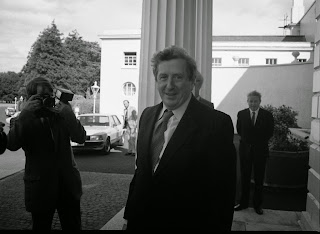After a prolonged bargaining period, the government are
finally moving closer to closing the deal on the sale of their 25% share in Aer
Lingus. The Minister for Transport, Paschal Donohoe, met with the unions early
this week to discuss how employees will be affected by the sale.
The sale will bring an end to the government’s involvement
in the airline, which helped establish it as the ‘national’ airline. Since its
foundation in 1936, Aer Lingus has been an important connection to the rest of
the world for Ireland. The fleet grew from its single 14-seater route to
Bristol, to serving 80 airports across Europe, the US, Africa and Asia, with
links to another 80 destinations in Asia and Australia through Etihad, JetBlue
and United Airlines.
Here are some highlights from the company’s history that
have been recorded in the Irish Photo Archive.
1. Blessing of the fleet
In the 1950s, the Catholic Church was a major player in
Irish society. Every new business, school, or factory had to be blessed before
it could start operating, and often would get a 'top-up' blessing as time went by. This image here shows the blessing of the Aer Lingusfleet in 1958.
 |
| The blessing of the Aer Lingus fleet 31 May 1958 |
2. The 21st Anniversary
The importance of Aer Lingus to Ireland was highlighted during their 21st anniversary celebrations in 1957. The new Aer Lingus house flag was hoisted in the middle of O’Connell Street as part of the celebrations. Air flights were still a luxury in those days, so that flag is probably the closest many of those onlookers got to an Aer Lingus experience.
 |
| The Aer Lingus flag being hoisted on O'Connell Street 27 May 1957 |
3. First Trans-Atlantic flight
The first transatlantic Aer Lingus route was set up in
1958, from Shannon to New York, using planes leased from the American Seaboard
and Western with an Irish Aer Lingus crew. Robert Wagner, the then Mayor of New
York, accompanied the planes across the Atlantic before they were officially
handed over to the Irish company. The flights officially operated under Aer Linte then, which had been set up in 1947 to promote transatlantic flights, until the new Taoiseach John A. Costello decided Ireland could not support such extravagant schemes. Aer Linte was merged with Aer Lingus in 1960, when the airline bought some Boeings for its own use.
 |
| Passengers waiting to board the first transatlantic flight from Dublin Airport 28 April 1958 |
4: The first female pilot
The first female pilot for Aer Lingus was Grainne Cronin,
who gained her pilot’s wings in 1979. Though this seems quite late, Aer Lingus
were actually quite innovative in this respect, being only the second European
airline (after SAS) to take on female pilots. Captain Cronin served 33 years
with Aer Lingus before retiring in 2010.
 |
| Captain Grainne Cronin taking the controls on her first flight with Aer Lingus 29 April 1979 |
5. The visitors
Aer Lingus brought many of the VIPs to Ireland on their
treasured visits, such as the Beatles, Muhammed Ali, Pope John Paul II, etc. Aer
Lingus became the only airline apart from Alitalia to have the privilege of
flying Pope John Paul when a specially modified Boeing 747 (EI-ASI or St.
Patrick) was used to bring him from Rome to Dublin.
 |
| Pope John Paul II having disembarked from his Aer Lingus flight to Dublin 29 September 1979 |
All images available @ Irish Photo Archive












